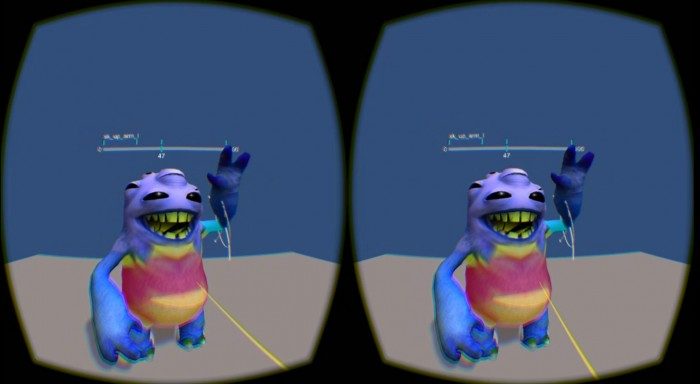Masters of Pie, a London based 3D animation studio, have taken a page out of the book of renowned claymation works such as Wallace and Gromit with their stop-motion animation prototype tool for VR, aptly code named Geppetto after the fictional creator of Pinocchio.
Masters of Pie created Geppetto to make it easier to visualize and animate the movement of a character by completely doing away with complex mouse-operated user interfaces inherent to 3D animation software. The prototype tool enables what the company is calling “digital puppetry” and uses the Oculus Rift DK2 and Razer Hydra for input.
See also: Exclusive: VRClay Beta Hands-on, the 3D Sculpting Software for VR
The studio uses the Hydra to give the user a fine ‘laser pointer’ that can manipulate the actual character mesh. Studio director Karl Maddix outlines the mechanics of Geppetto in a blog post.
“…our solution was to look at the bones associated with the nearest vertex, choose the bone with the biggest weight or influence on the mesh and then take this as the bone that we wish to move. This all happens almost instantaneously as we waft the laser around the mesh, and so as a visual aid, we have a coloured vertex system that will highlight from red to yellow, the currently selected area of influence. We can immediately and easily choose exactly the part we want to move.”
Maddix told us that Geppetto reveals a “surprising impact of scale when animating, [including] the ease of grabbing and moving to wherever you want, and of course the [character’s] full body involvement.”
Although the prototype is not yet public, Road to VR Executive Editor Ben Lang had a chance to try out Geppetto first-hand (or first Hydra).
I’ve always been a fan of experiences that use 1:1 hand input like the Razer Hydra. The intuitive nature of such systems means that users can manipulate digital information in a way that’s completely natural to them. It’s like being able to make use of a tool without having to learn how the tool itself works.
 Case in point: I’ve never animated any 3D object in my life. After five minutes of poking around inside Gepetto to see how it works, it took me only another five minutes to pose the default alien character in a pretty epic disco pose (if I do say so myself).
Case in point: I’ve never animated any 3D object in my life. After five minutes of poking around inside Gepetto to see how it works, it took me only another five minutes to pose the default alien character in a pretty epic disco pose (if I do say so myself).
Although still very much a prototype, the core functionality of Gepetto is clear and useful: Point to the part of the model that you want to move and you can hold down the Hydra’s trigger for quick and coarse manipulation. If you want to get precise, let go of the trigger and up pops a floating gizmo that allows you to make fine adjustments along each axis of the selected part.
Above the character is a timeline which allows users to animate by associating poses with particular moments (keyframes) on the timeline. When played back, the character moves from one pose to another accordingly.
Gepetto won’t make you an expert animator, but it can give even a novice the opportunity to start learning.
Although still in its first stage of development, Masters of Pie have said that successive stages of Geppetto could include a plug-in for Maya, a powerful animation software that would add a large array of tools to the intuitive prototype tool.
“We are looking forward to being able to move into the next stage to add and refine features, but for now it is a fun thing to play with for half an hour (which is more that can be said for Maya!),” Maddix said.







